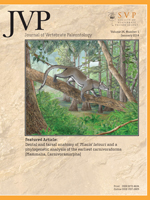A new Late Cretaceous avian taxon, Parvavis chuxiongensis, gen. et sp. nov., is reported here based on an incomplete skeleton from Upper Cretaceous lake deposits in Yunnan Province, southern China. A phylogenetic analysis of 32 taxa and 242 morphological characters resulted in three most parsimonious trees, the strict consensus tree of which places Parvavis chuxiongensis within Enantiornithes. Histological study shows that the bones of Parvavis were composed of parallelfibered bone tissue without lines of arrested growth, and indicated that growth rate had slowed but had not stopped at any stage prior to death. The bones also lack the rough surface texture seen in juvenile birds. Therefore, the new bird was probably close to adult body size at the time of death. However, the specimen is surprisingly small, highlighting the wide range of body sizes in Upper Cretaceous enantiornithines. The new specimen also represents both the first known bird from the Upper Cretaceous of China and the first Mesozoic bird from the south of China, and thus extends the temporal and geographic range of Mesozoic birds in China.
How to translate text using browser tools
1 January 2014
The First Enantiornithine Bird from the Upper Cretaceous of China
Min Wang,
Zhonghe Zhou,
Guanghui Xu
ACCESS THE FULL ARTICLE





